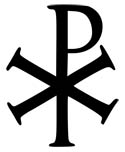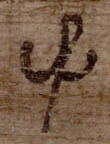 The glyphs or symbols that are commonly used by modern astrologers to represent the planets and signs of the zodiac were only firmly established in the Middle Ages. While there is evidence that some of these glyphs may have evolved out of certain symbols that were used during the late Hellenistic tradition, and some possibly from ancient Egyptian script known as Demotic, for the most part the early Hellenistic astrologers do not appear to have employed glyphs to represent planets and signs very frequently. Instead they tended to write out their full names as words.
The glyphs or symbols that are commonly used by modern astrologers to represent the planets and signs of the zodiac were only firmly established in the Middle Ages. While there is evidence that some of these glyphs may have evolved out of certain symbols that were used during the late Hellenistic tradition, and some possibly from ancient Egyptian script known as Demotic, for the most part the early Hellenistic astrologers do not appear to have employed glyphs to represent planets and signs very frequently. Instead they tended to write out their full names as words.
One of the early exceptions to this seems to be the ascendant, or horoskopos, as it was called in Greek. There is evidence that a number of astrologers used something resembling the above symbol as a sort of shorthand or glyph to refer to the ascendant.
It is not really a glyph though so much as it is an monogram, as it is simply the first two letters of the word for the ascendant (omega, ω, and rho, ρ) superimposed on each other to form a single symbol.
 Other monograms like this one were used in ancient times to represent various things. The most famous is probably the Chi Rho symbol that was adopted by the Roman emperor Constantine in the early 4th century, with Chi and Rho being the first two letters of the Greek word “Christos,” i.e. “(Jesus) Christ.”
Other monograms like this one were used in ancient times to represent various things. The most famous is probably the Chi Rho symbol that was adopted by the Roman emperor Constantine in the early 4th century, with Chi and Rho being the first two letters of the Greek word “Christos,” i.e. “(Jesus) Christ.”
The astrological symbol shows up frequently in horoscopes written on papyri that have been recovered from the waste dumps of the ancient Greco-Roman city of Oxyrhynchus in Eygpt.
 Here is an example of what the symbol looked liked on a piece of papyrus, from P.Oxy. XLVII 3353. The full horoscope is available here: http://www.csad.ox.ac.uk/POxy/papyri/vol47/300dpi/3353_300.jpg
Here is an example of what the symbol looked liked on a piece of papyrus, from P.Oxy. XLVII 3353. The full horoscope is available here: http://www.csad.ox.ac.uk/POxy/papyri/vol47/300dpi/3353_300.jpg
This horoscope was dated to February 12, 179 by Donata Baccani in Oroscopi Greci, pgs. 127-131. The symbol appears towards the top left of the fragment.
In this instance the symbol is used to refer to the hour rather than the horoskopos directly. Neugebauer and van Hoesen point out in Greek Horoscopes (pg. 163) that the symbol is sometimes applied to the ascendant, sometimes to the hour of day, or sometimes to both in the same text. This continues to hold true in Alexander Jones’ more recent collection, Astronomical Papyri from Oxyrhynchus.
If you are interested in looking into this topic further, Deborah Houlding has an interesting article on Skyscript where she dissects and decodes a chart from the late 5th/early 6th century: http://www.skyscript.co.uk/greek_horoscope.html
Very Cool.
Fascinating. I’m struck by how elegant are both of the forms of the horoskopos glyph. If only I were a caligrapher . . .
Hallo Chris,
I think, the single letter behind the glyph/ligature shows usullay a number, see at Neugebauer/Hoesen, Greek Horoscopes. So the glyph can’t be an abbreviation for horoscopos.
Hi Andreas,
In some of those instances where a number follows the ligature it is simply referring to the hour in which the person was born, while in others it is clearly being used as shorthand to refer to the hour-marker. This is very clear in Jones’ collection.